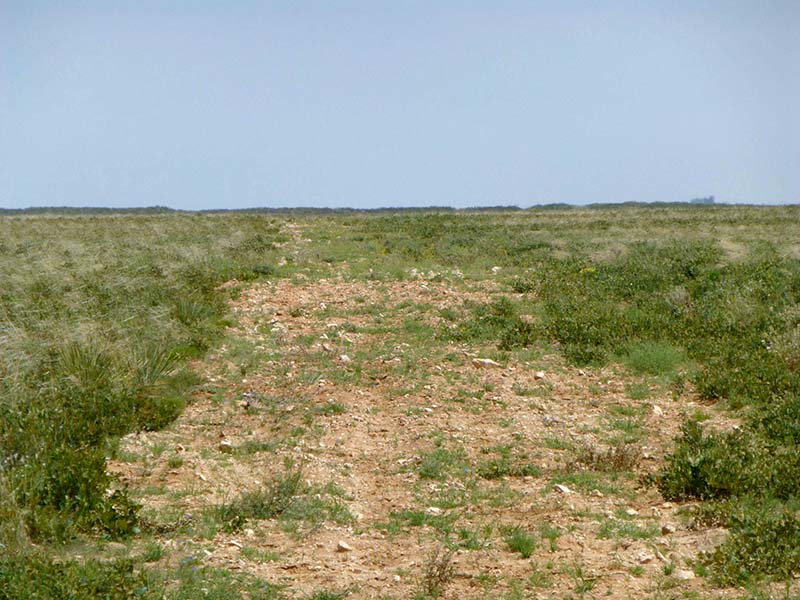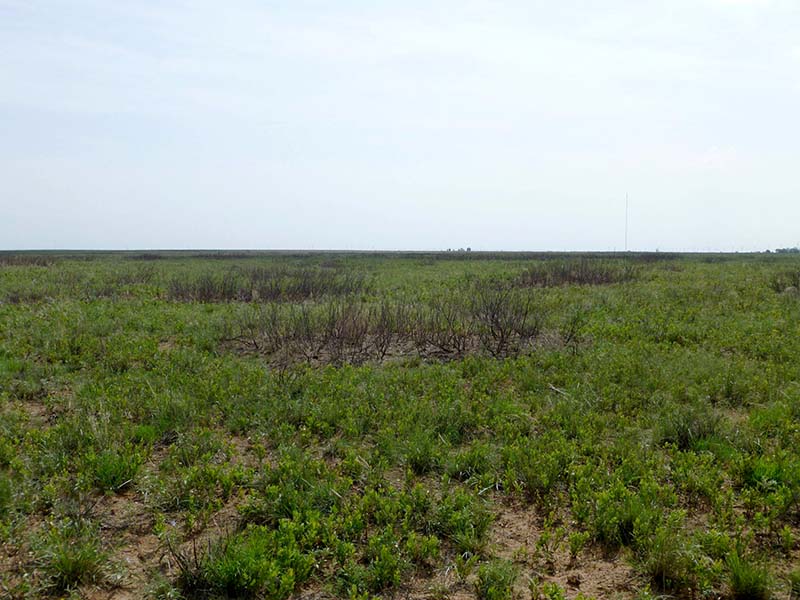Grasslands are one of the most threatened ecosystems in North America, and grassland birds are experiencing some of the most significant population declines. According to PLJV’s 2010 landcover analysis, there are about 57 million acres of grassland in the PLJV region. Since most of the land is privately owned, we often work in collaboration with landowners and producers to restore or protect these working lands.
We often work in collaboration with landowners and producers to restore or protect these working lands.
Across the region, grasslands continue to be lost due to agricultural conversion and woody plant encroachment. Each year, approximately 500,000 acres of grass, or 0.88%, are converted for row crop agriculture. According to published data about woody plant encroachment, the average rate of invasion in the PLJV region is 2% per year, or approximately 1.1 million acres.
To stem continued grassland bird declines, the conservation community needs to protect healthy grasslands and prevent further loss. While approximately 1.2% of our landscape is already protected as public land or under conservation easements, our goal is to have 5% of our landscape protected in the next 15 years. In addition, we need to restore 17 million acres of grass through conservation programs such as the USDA Conservation Reserve Program (CRP) and remove woody invasive plants from more than 11 million acres of grasslands.
If we achieve this goal, we will have restored enough grassland habitat to support all of our grassland birds at 100% of our goal. In addition, grass buffers planted around playas will also support playa restoration and contribute to our waterfowl and shorebird goals. Learn more about our grassland and other habitat goals in the PLJV Implementation Plan.
Acres Currently on the Landscape
Planning Area | Grassland | CRP Lands | Woodland, Shrubland, & Savannah |
Colorado | 11,700,000 | 1,641,500 | 0 |
Kansas | 6,500,000 | 1,616,450 | 0 |
Nebraska | 3,900,000 | 540,000 | 12,100 |
New Mexico | 11,100,000 | 388,000 | 1,963,000 |
Oklahoma | 7,100,000 | 585,000 | 952,100 |
Texas | 2,375,000 | 13,200,000 | 14,722,000 |
Acres of Conservation Needed Annually
Planning Area | Protection | Restored (CRP & Other Programs) | Woody Plant Removal |
Colorado | 35,000 | 458,850 | 175,000 |
Kansas | 35,000 | 323,400 | 153,400 |
Nebraska | 35,000 | 72,890 | 148,200 |
New Mexico | 35,000 | 99,780 | 503,700 |
Oklahoma | 35,000 | 221,260 | 270,700 |
Texas | 35,000 | 1,052,000 | 1,556,600 |
These tables show how many acres of grassland are currently on the landscape in each state and how many acres need to be restored and protected each year for the next 10 years to meet our grasslands goals as described above. Because the grassland landscape is continually changing, we have factored in the projected loss of grasslands from woody plant encroachment, which ranges from a low of 1% loss in western Kansas to a high of 10.2% loss in western Oklahoma, when determining our annual grassland restoration and protection goals.
How We Are Conserving Grasslands
In the stories below, you’ll see a few of the ways the PLJV partnership is implementing grassland conservation and restoration strategies to meet our goals — such as applying social science results to inform how we work with landowners to manage invasive plants and investing in organizations working with landowners to conserve grasslands by keeping working lands working. While no one strategy will meet our goals, all of the individual efforts do add up and make a difference. To learn more about the partnership’s conservation strategies, read about our Implementation Plan and view the strategies tables.
Social Science to Inform Woody Plant Management
The scale and speed of woody plant encroachment demands the development of innovative approaches to brush management and prevention. A grant from USDA Natural Resources Conservation Service is providing funding to develop an effective outreach model by integrating social science insights into targeted strategic communications that increase woody plant management and prescribed fire on rangelands in Kansas and Oklahoma.
Over three years, PLJV will collect social science information about brush management needs and barriers to participation in management activities, create and evaluate targeted communication messages and products that address those barriers and aim to increase participation in management actions, and work with agencies, conservation programs and local partners to deliver these communication messages to producers through marketing communications campaigns and producer-focused outreach events. The social science insights and communication products can then be adapted and used by partners across the region.
Building Capacity for Grassland Conservation
The Land Trust Program is helping to build capacity for grassland conservation by investing in organizations, such as Ranchland Trust of Kansas, to help develop their ability to deliver long-term bird habitat conservation through multi-year grants. Our objective is for 5% of undisturbed grasslands within our region to be protected from development, with the vast majority remaining as working lands. For each grant, we expect the return on investment to be approximately 175,000 acres or more of rangeland protected over the grant period.
In 2020, New Mexico Land Conservancy received a grant to strengthen the organizational infrastructure of their Grasslands Program by building technical expertise for biological planning both in-house and through partnerships, improving capacity for landscape-scale planning to prioritize habitats, improving landowner outreach and access to training for staff in the areas of habitat protection and enhancement, and increasing the diversity of funding sources.
The 2021 capacity grant will help Texas Agricultural Land Trust extend its reach among landowners, support the negotiation of conservation easements, educate landowners about conservation practices, and foster collaboration with key conservation partners. Its strong relationships with conservation organizations across Oklahoma — including the Texas and Southwestern Cattle Raisers Association, Farm Bureau, and the Noble Research Institute — make it well positioned to connect with landowners who engage across these groups in both Texas and Oklahoma.
New Mexico Partners Restore Rangeland
Lesser Prairie-Chickens require large areas of intact grasslands, with the range-wide conservation plan recommending focal areas of at least 50,000 acres. However, much of their habitat has been fragmented and degraded, partly from oil and gas infrastructure. In 2009, PLJV began working with Restore New Mexico — a conservation collaborative including the Bureau of Land Management, New Mexico State Land Office, New Mexico Department of Game and Fish, USDA Natural Resources Conservation Service, Soil and Water Conservation Districts, and other organizations — to remove abandoned oil and gas well pads and associated roads, as well as invasive woody plants, and replant the areas back to native grass. PLJV provided geospatial analysis to identify and prioritize the reclamation work.
By removing caliche roads and oil pads on 86 acres and invasive woody plants from over 362 acres, the project created approximately 6,000 acres of suitable nesting habitat for Lesser Prairie-Chicken that were previously unsuitable. The project also included the purchase of a ranch within the core breeding area that, when added to six other protected properties nearby, created a 38,000-acre area of intact grasslands.
Since that project, Restore New Mexico has continued to focus on improving habitat conditions for Lesser Prairie-Chicken and rangeland for local ranchers by removing invasive mesquite, which are identified using a Lesser Prairie-Chicken Initiative model. PLJV is working with Restore New Mexico to update the mesquite canopy model to identify priority areas for future work and create a process to allow for periodic updates to the model and priorities. PLJV will also use IMBCR to evaluate the effects of mesquite removal on grassland birds.





